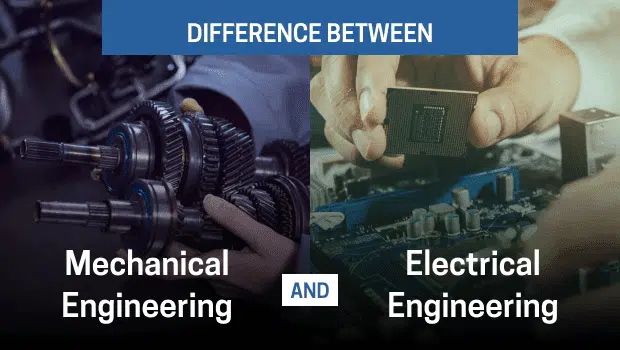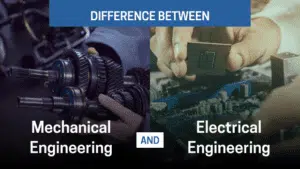
Engineering is a dynamic field that offers impactful and lucrative opportunities along with the scope for advancements. This field requires a unique set of math, science, and computer skills. The term “engineering” refers to a wide range of specializations, including but not limited to computer, telecommunication, civil, mining, information technology, and so on, of which mechanical and electrical engineering are two subsets.
Mechanical and electrical engineering are the driving forces behind technological progress and change in the world of design. These disciplines work closely in building projects and hence, it becomes to establish a thin line between the both. Possessing an understanding of the difference between the two gives a better idea of projecting and executing a successful project plan.
Electrical Engineering – Power Generation
Electrical engineering focuses on the study, design, and implementation of devices and systems that make use of electrical current, electronic circuitry, and electromagnetism. It is nucleated into different fields like computer engineering, system, power, telecommunication, radio-frequency, signal processing, instrumentation, photovoltaic cells, optics engineering, etc.
- Power and energy
Engineers’ design here deals with the generation, transmission, and distribution of electricity and the design of connected devices. This involves working on the power grid and off-grid systems. The technological future in this sector is a real-time feedback loop controlled by satellites to prevent power surges and blackouts.
- Telecommunications
Engineers’ design here deals with the information transmission across a communication channel like cables, optical fibers, or free space. This involves modulation techniques like amplitude modulation and frequency modulation. Later, communication is established between transmitters and receivers, via a transceiver.
- Control engineering
This focuses on the modeling of dynamic systems and the design of controllers that will help systems to perform in the desired manner. Electrical products used in this case are electronic circuits, digital signal processors, microcontrollers, and programmable logic controllers. These intricate designs are used in automobiles, airlines, cruise control, industrial automation, robotics, etc.
- Electronics
Electronic engineering entails the design and testing of electronic circuits that utilize the properties of components such as resistors, capacitors, inductors, diodes, and transistors to achieve a specific function. Integrated circuits are the modern electrical components that allow a device to generate the expected output.
- Microelectronics and nanoelectronics
Microelectronics engineering designs and microfabricates small electronic circuit components for use in integrated circuits or as general electronic components. Nanoelectronics is the reduction of devices to nanometer dimensions. Both these involve the integration of chemistry and material science along with engineering postulates to redefine technology.
- Signal processing
It deals with the analysis and manipulation of signals. These signals can either be analog or digital, based on the information transferred. Signal Processing is the mathematical core of digital signal processing. It is rapidly expanding with new applications in every field of electrical engineering, such as communications, control, radar, audio engineering, biomedical engineering, etc., as analog systems are replaced with digital counterparts.
- Photonics and optics
Photonics and optics involve the production, transmission, amplification, modulation, detection, and examination of electromagnetic radiation. The application of optics involves the design of optical-electrical products, such as lenses, microscopes, telescopes, electro-optical sensors, etc., that utilize the properties of electromagnetic radiation.
Mechanical Engineering – Power Applications
Mechanical engineering is a discipline that combines engineering physics and math principles with material science to design, analyze, and manufacture mechanical systems. The core of this field is an understanding of mechanics, dynamics, thermodynamics, material science, structural analysis, and electricity.
It involves the use of tools like computer-aided design, computer-aided manufacturing, management and design of manufacturing plants, industrial equipment, aircraft, robotics, home automation, medical devices, transport systems, etc. It is nucleated into-
- Mechanics
It is the study of forces that act upon matter and is used to analyze and predict the acceleration and deformation of objects under forces. This involves subdisciplines of statics, dynamics, mechanics of materials, fluid mechanics, kinematics, and continuum mechanics.
- Mechatronics and robotics
Mechatronics combines mechanics and electronics. This interdisciplinary branch of mechanical, electrical, and software engineering integrates electrical and mechanical engineering to create hybrid automation systems. Electric motors, servo-mechanisms, and other electrical systems can automate machines with special software.
Robots are used in industrial automation processes to perform labor-intensive tasks like bomb disposal, space exploration, heavy-load transportation, etc.
- Structural analysis
It is a branch of mechanical engineering that deals with the performance of objects. This involves two modes- static failure and fatigue failure. Mechanical engineers design frequently use structural analysis after a failure has occurred or when designing to prevent failure.
- Thermodynamics and thermo-science
Thermodynamics is the study of energy and its transformation through a system. Engineering thermodynamics is concerned with changing energy, eg., in automobiles chemical energy is converted to heat energy. It is used in fields of heat transfer, thermofluids, and energy conservation.
Thermo-science on the other hand is used to design power plants, heating, ventilation, HVAC, heat exchangers, radiators, refrigeration, etc.
- Design and drafting
Mechanical engineers use drafting or technical drawing to design products and create instructions for manufacturing parts. They use computer-aided design (CAD) to create 3D designs. CAD-created three-dimensional models are also commonly used in finite element analysis (FEA) and computational fluid dynamics (CFD) (CFD).
Mechanical Engineering vs Electrical Engineering
- Electrical engineering is more concerned with electricity and power generation systems, whereas mechanical engineering is more concerned with machines and their efficiency.
- Electrical engineering is more abstract because it discusses invisible waves, whereas mechanical engineering is less abstract because students can see what they are studying.
- Mechanical engineering is an older branch of engineering than electrical engineering, which developed rapidly after the invention of electricity and Michael Faraday’s formulation of its laws.
- Electrical engineering is significantly more theoretical and mathematical than mechanical engineering.
Final Thoughts
Engineering is all about making current processes work better and integrating them with modern technology. Mechanical and electrical engineering helps in creating solutions and boosting performance-oriented businesses. The thin line between both disciplines is visible, but their integration is important to bring an idea to reality.
Technosoft Engineering provides mechanical and electrical engineering solutions to bring your ideas to reality. With a cross-functional approach, we aim to merge ideas with ultra-modern technology and use the same to solve a problem statement. Our services are, but are not confined to home automation, medical devices, plant automation, automobile, smart packaging, embedded systems, etc.
Get in touch with us today and bring in ultra-modern solutions in the real world.
